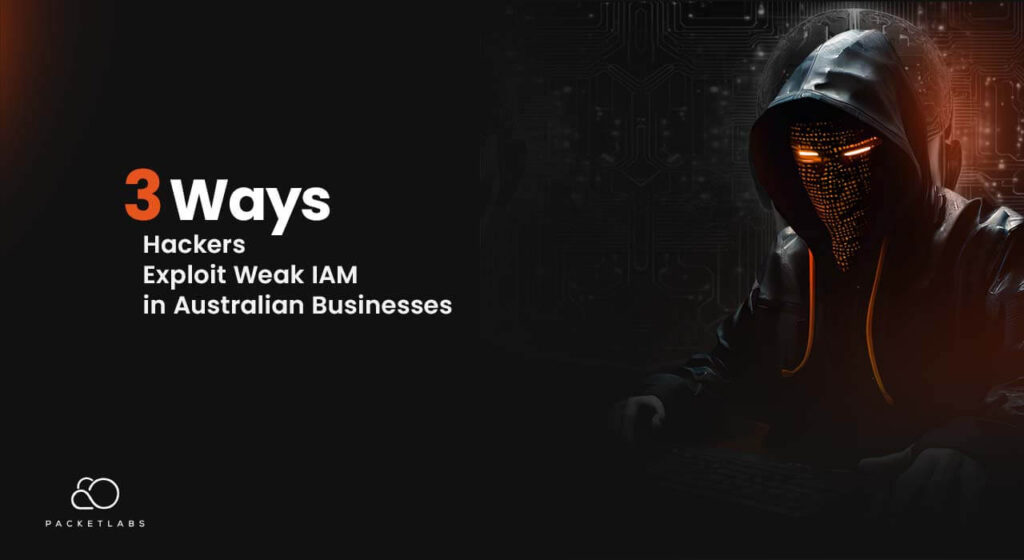
n today’s digitally driven landscape, Australian businesses operate amidst a constantly evolving cybersecurity threat environment. Data breaches, malware attacks, and unauthorised access attempts pose significant risks to sensitive information, financial stability, and brand reputation. To navigate this complex landscape effectively, businesses require robust security practices, and Identity and Access Management (IAM) plays a crucial role in this defence.
IAM refers to the framework that governs how users access organizational resources, ensuring only authorized individuals have access to the right information at the appropriate level. A robust IAM system acts as the first line of defence, preventing unauthorized access and mitigating the potential impact of cyberattacks.
This article delves into the criticality of strong IAM for Australian businesses. We will explore three prevalent methods employed by hackers to exploit weak IAM practices, highlighting the potential consequences of inadequate protection. By understanding these vulnerabilities and implementing appropriate safeguards, businesses can significantly enhance their cybersecurity posture and safeguard valuable assets.
Understanding IAM and its Importance
Identity and Access Management (IAM) encompasses the policies, technologies, and processes that govern how users within an organization access its resources. This framework ensures authentication (verification of a user’s identity), authorization (granting access to specific resources based on their role and permissions), and access control (enforcing these permissions).
Implementing robust IAM practices offers significant benefits for Australian businesses:
- Enhanced security: Through the regulation and oversight of user access, organisations are able to substantially diminish the likelihood of unauthorised entry into confidential data and systems.
- Improved compliance: Strong IAM aligns with Australian regulations like the Australian Privacy Principles (APPs), which mandate businesses to protect personal information from unauthorized access or disclosure.
- Increased efficiency: Automated user provisioning and deprovisioning streamline the process of managing user accounts, saving time and resources.
- Reduced operational costs: Effective IAM can minimize the potential financial losses associated with data breaches and cyberattacks.
The Australian cyber threat landscape is ever-evolving, with attackers becoming increasingly sophisticated in their methods. Weak IAM practices leave businesses vulnerable to exploitation. Hackers can leverage readily available information through social engineering techniques, exploit unpatched vulnerabilities in systems, or gain access through compromised credentials to breach defences. These unauthorized intrusions can result in data breaches, financial losses, reputational damage, and even legal ramifications.
Therefore, implementing robust IAM practices is no longer optional for Australian businesses. It has become a fundamental requirement to ensure data security, maintain compliance, and safeguard sensitive information in today’s dynamic digital environment.
3 Ways Hackers Exploit Weak IAM
1. Brute-force attacks and weak passwords

Hackers often employ brute-force attacks, a method where they systematically try a large number of password combinations to gain unauthorized access to accounts. These attacks exploit weak passwords, which can be easily guessed by hackers or cracked using specialized software. The potential impact of a successful brute-force attack can be devastating, allowing unauthorized access to sensitive information, systems, and even financial resources.
Australian businesses can significantly mitigate this risk by implementing strong password policies. These policies should enforce password complexity, requiring a minimum length, a combination of uppercase and lowercase letters, numbers, and special characters. Additionally, enforcing regular password rotation (e.g., every 3-6 months) further strengthens password security.
The Australian Cyber Security Centre (ACSC) provides valuable resources and guidance on creating robust password policies for businesses: [https://www.cyber.gov.au/].
2. Phishing and social engineering
Phishing emails and social engineering tactics exploit human vulnerabilities to trick individuals into revealing sensitive information or clicking on malicious links. Phishing emails often appear to be from legitimate sources (e.g., banks, government agencies) and may contain urgent requests or enticing offers. Clicking on malicious links within these emails can lead to the installation of malware or redirect users to fake login pages designed to steal credentials.
Social engineering tactics involve manipulating individuals through psychological pressure, urgency, or exploiting trust to gain access to information or systems. This can involve impersonating an authority figure, creating a sense of urgency, or leveraging personal information to gain the victim’s trust.
To combat these threats, Australian businesses should raise employee awareness through cybersecurity training programs. These programs should educate employees on identifying phishing attempts, recognizing social engineering tactics, and understanding the importance of reporting suspicious activity. Resources like the Stay Smart Online initiative by the Australian Government provide valuable guidance for businesses and individuals: [https://www.directory.gov.au/portfolios/defence/department-defence/stay-smart-online].
3. Privilege escalation and insider threats
Weak IAM practices can also leave businesses vulnerable to privilege escalation. Hackers may exploit unpatched software vulnerabilities, readily available default credentials, or compromised user accounts to gain initial access to a system. Once inside, they can then leverage various techniques to escalate their privileges, gaining access to more sensitive data and systems.
Furthermore, insider threats pose a significant risk. These risks arise from personnel within an organisation who exploit their authorised access for malevolent purposes. Disgruntled employees, contractors, or even individuals with compromised accounts can pose a serious threat to data security.
Mitigating these risks requires a multi-pronged approach. Applying the principle of minimal privilege is essential. This principle dictates that users should only be granted the minimum level of access required to perform their job functions. Additionally, businesses should enforce multi-factor authentication (MFA) for critical systems, adding an extra layer of security beyond passwords.
Regular system audits and penetration testing can identify vulnerabilities that attackers might exploit. Finally, fostering a culture of security awareness within the organization, encouraging employees to report suspicious activity, and implementing appropriate disciplinary measures for misuse of access privileges can significantly reduce the risk of insider threats.
Strengthening IAM Practices in Your Business
Fortifying your IAM posture requires a proactive and multifaceted approach. Here are actionable steps Australian businesses can take:
- Implement strong password policies: Enforce password complexity, length requirements, and regular rotation, as outlined in the previous section.
- Multi-factor authentication (MFA): Implement MFA for critical systems, adding an extra layer of security beyond passwords.
- Principle of least privilege: Grant users the minimum access level necessary to fulfill their job duties.
- Regular security audits and penetration testing: These assessments uncover vulnerabilities before attackers do, allowing for timely remediation.
- Ongoing employee training: Regularly educate employees on cybersecurity best practices, including phishing awareness, password hygiene, and reporting suspicious activity. Resources like the Australian Cyber Security Centre’s (ACSC) Essential Eight provide valuable guidance: [https://www.cyber.gov.au/resources-business-and-government/essential-cyber-security/essential-eight].
- Review and update IAM policies regularly: Regularly review and update your IAM policies to address evolving threats and ensure alignment with industry best practices.
By implementing these measures, Australian businesses can significantly bolster their IAM practices, creating a more robust defence against cyber threats and safeguarding valuable information, systems, and ultimately, their reputation.
In today’s dynamic digital environment, robust Identity and Access Management (IAM) is no longer a luxury, but an essential requirement for Australian businesses. Implementing robust IAM practices not only safeguards sensitive data and systems but also fosters trust with stakeholders and upholds compliance with data security regulations. By taking action and implementing the suggested strategies, businesses can significantly strengthen their cybersecurity posture, mitigating the risk of cyberattacks and ensuring the continued success and growth of their organizations.
